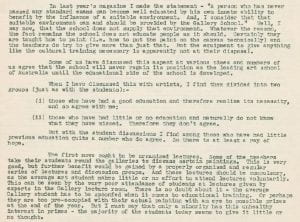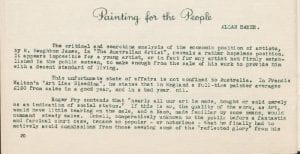Impoverished Artists
Laurence Marvin S. Castillo
The Daub art magazines produced by the students of the National Gallery Art School offer glimpses into the practices of art pedagogy in mid-twentieth century Australia. The magazines feature essays, short stories, poetry and drawings by students that critically and creatively index the contours of, and contradictions in, the learning institution as a cultural field.
The 1948 issue is particularly revealing of how art was viewed and located in the socio-economic grid of industrialisation after the second World War and it registers student concerns about the apparent subordination of the arts in Victoria’s pedagogical ambitions.

Lucy Kerley’s article, “What Then?,” for instance, lamented the inadequacy of cultural training in the art school. While most students content themselves with skills-based training, Kerley believed that it was also important to pursue a theoretical and discursive intellectual trajectory that would acquaint students with topics like the history of art. She went on to suggest that such gaps stemmed from the lack of state support.

Alan Baker’s essay, “Painting for the People”, echoed the same clamour for government responsibility, this time in relation to forms of public engagement with the arts beyond academe. Baker criticized society’s treatment of artists, as evinced particularly in the meritocratic working of art sales that relied primarily on name-recall, notoriety as in the case of William Dobell, or prominence through prizes. To respond to this aesthetic conundrum of valuing neither the artworks nor the artists would require a collective effort to raise public appreciation for the arts, something that could be spearheaded by the state through the establishment of public institutions for cultural appreciation, provision of grants, and promotion of cultural activities.
These two articles revolved around some of the repercussions of the capitalist rationalism that compelled the postwar state to prioritise enterprises that could readily oil the engines of accumulation. The threat posed by an economic boom, which disenchanted many artists with the encroachment upon artistic practices by the commodifying culture of capitalist modernity, unleashed other romantic impulses. Fantasies of an alternative idyll were evoked in Nell Markey’s short story “Don’t Marry an Artist,” in which a woman and her artist-husband express their desire to escape to an uninhabited island where the husband could paint in peace, free from the burden of social expectations and competitive fellow artists, as well as in Lesley Barnes’ “Teaching Art in a Country High School,” which depicted the country as a ground filled with imaginative possibilities for a city-based sojourner.
It is fascinating that the writers of these articles, including Lucy Kerley who trained as a biochemist without abandoning her engagement with the School of Arts, were committed to arts-related career and practices, in spite of the concerns that they raised in the magazine. And indeed, these concerns continue to resonate in the current neoliberal dispensations of the state. With the present-day commodification of artistic practices and the defunding of the arts and humanities, many artists and art students would surely not be hard-pressed to ask, “what then?”
Laurence Marvin Castillo is a PhD student at the Asia Institute of the University of Melbourne. His research project is about the literary and cinematic representations of communism in post-dictatorship Philippines.
Leave a Reply